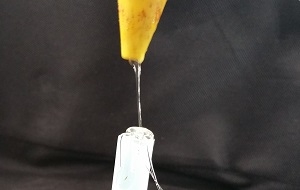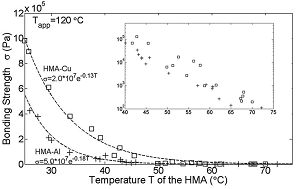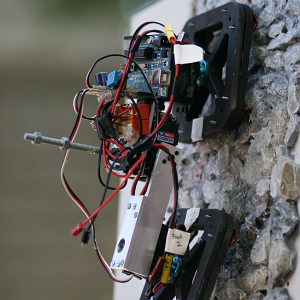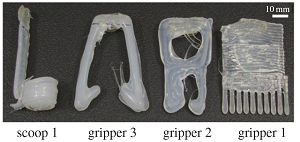Hot Melt Adhesives (HMA)
| HMAs, also known as hot glue, are (co)polymer-based thermoplastic adhesives. They form bonds between any solid surfaces by a thermally induced solidification process. Although this process can sound very technical, it is actually no more complicated than the usage of a glue gun to melt down the supplied HMA material into liquid, and wait for less than a minute in room temperature for the liquid HMA to cool down and become solid again. This simple phase transition process is bidirectional and highly repeatable. That is why we are exploiting this key feature of HMA to build soft robots and add and remove parts from them if necessary with just a couple of HMA sticks and a glue gun. In short, while hot liquid HMA glues parts together, the cold solid HMA becomes the soft elastic robot body. |
A hot glue gun can easily melt down the HMA by heating up the glue stick to 150◦C. HMA is adhesive in hot liquid phase and a strong elastic in cold phase. |
| Depending on the temperature, HMAs have three different phases: first, at room temperature (around 25◦C), the material is a viscoelastic solid and has no adhesiveness. That means HMAs cannot form a new bond between surfaces, while an existing connection can be maintained with a high bonding strength. Second, at a temperature around a softening point (around 82-92◦C) the material starts to become viscoplastic and adhesive. It is difficult to maintain an established connection since the bond is dramatically weakened by the low shear stress. And third, at a higher temperature than the melting point (generally 170◦C) the cohesive strength becomes so low that the material transforms into a low-viscosity fluid. |
Bonding strength of HMA to copper and aluminum with respect to temperature (adapted from Wang et al. 2012) |
| In the Biologically Inspired Robotics Laboratory, we have been using HMA extensively in a very large range of robotic applications and projects. From a climbing robot which uses it as a bonding material to attach to different surfaces (Wang et al. 2013), to robots which uses it as a structure material to print tools to carry objects (Wang et al. 2014) and tools to sense different stimuli (Nurzaman et al. 2013). We also have showed that complex robots can be built with this material within the time limits of our previous university lectures (Yu et. al 2014). It is up to the imagination and creativity of the user what else can be done with HMAs! | |
|
Climbing robot which uses HMA to stick to rock walls (adapted from Wang et al. 2013) |
Tools made out of HMA to carry different objects such as water, wooden cubes and grains of rice (adapted from Wang et al. 2014) |




